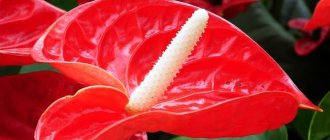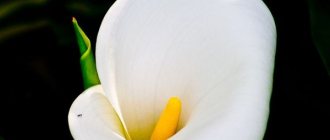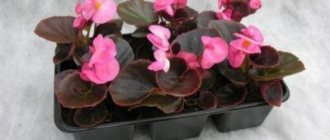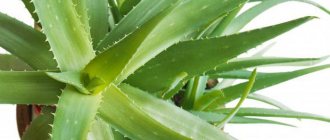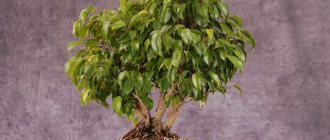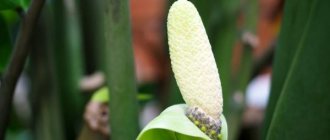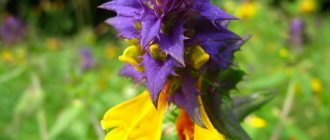Our ancestors endowed begonia with magical properties. It was believed that it could ease the intensity of emotions and prevent the development of depression. Wherein the flower promises material well-being, mutual love and a sea of happiness.
It is noticed that:
- If the plant withers, then the situation in the house will deteriorate.
- If the flowers on the plant begin to turn pale, expect bad news.
- The bush withers for no apparent reason - diseases will come to your home.
Some types of begonia have their own character.
Superstitions for the home
To create a cozy atmosphere in the house, housewives plant flowers. But they don’t always remember that each plant has its own energy. Sometimes a real “energy vampire” can be hidden behind an elegant and delicate flower. The flower absorbs bad energy, spreading a positive attitude around. Looking at cute flowers, you don’t want to think or remember anything bad. Instead of mental anxiety comes calm and peace.
Our ancestors also noticed the peculiarities of indoor begonia ; signs and superstitions for the home associated with it were not born out of nowhere.
- It was believed that a flower in the house affects relationships in the family. If spouses often quarrel, the plant can influence their speedy reconciliation and create an atmosphere of peace and tranquility.
- Even if there is complete discord between husband and wife, begonia will help avoid a breakdown in relations and revive faded feelings.
- The plant has the power to establish mutual understanding not only between spouses, but all family members, children and parents.
Signs endowed begonia with magical powers.
Is it worth growing in an apartment?
Can I keep it at home? You can keep any flowers in your house that you and your family like. You shouldn’t blame this little flower for your successes and failures. You may believe that your beautiful begonia brings you good luck and even consider it a talisman. However, you should not expect that while the hostess is lying on the sofa, the begonia will bring a bag of money and a prince in love to her doorstep.
Important! We are responsible for our pets. For their condition and life. And begonia will definitely reward you with clean air and beautiful flowers.
Frankly, I also suffer from superstition, and I believe that a person who takes responsibility for his life only on himself is a sure sign that the plants in his house will be well-groomed and healthy.
Get begonias if you like them, take care of them, achieve success in life and believe in your strength, and not in the signs invented by someone!
Superstitions for money
The flower was considered to have the ability to attract money, prosperity, and prosperity. Moreover, the plant was grown in a green pot, and before planting, a little rice was thrown into the bottom of the bowl. It was believed that this enhanced the properties of the flower.
There are signs associated with the flowering of the plant:
- Lush flowering promises financial profit.
- A flowering bush influences the development of commercial thinking.
- The plant helps to attract new profitable partners for business development.
To ensure success in business, the flower must be kept not only at home, but also in the office, on the table, next to the computer. Then the family will be in order at work and at home with money.
Feng Shui meaning
According to the teachings of Feng Shui, begonia fills with energy not only the elderly, but also weakened people who are sick or have recently undergone surgery. If you leave a potty in such a person’s room, over time he will recover, become more cheerful, more active, and gain a desire to live.
According to Feng Shui, begonias belong in offices or work rooms. The plant helps to concentrate and stimulates brain activity. If conflicts often occur between employees, it will help smooth out relations. It is obvious that the science of Feng Shui and folk signs attribute the same properties to the plant.
Healing properties
Indoor signs and superstitions for the home attributed begonias to the ability not only to protect, but also to heal. The leaves of the plant secrete substances called phytoncides that kill bacteria. Thus, the surrounding air becomes cleaner from dust, toxins, and various infectious agents.
Modern medicine uses medicines based on flower juice :
- painkillers;
- antihistamines;
- for the treatment of hypertension.
Begonia juice is used to treat non-healing wounds and is used as an antiseptic. Begonia on the windowsill helps recovery by cleansing the aura of unhealthy energy. If you place a tropical bush next to the bed of a sick person, he will feel better. And if the plant blooms, a speedy recovery will come.
Benefit
Bactericidal action. Purifies the air from pathogenic bacteria, as well as dust and toxic substances.- The phytoncides secreted by begonia destroy infections. Substances synthesized by the plant kill most fungi and microorganisms.
- The juice of the plant has an antihistamine, antiseptic and analgesic effect, and also improves blood circulation and reduces high blood pressure.
- Preparations prepared from begonia are used in medicine: to treat wounds, sprains, bruises and other injuries, as well as stomach ulcers and pulmonary diseases.
- It is a powerful generator of positive energy. Absorbs and transforms negative currents, giving back a positive charge.
- Like a cactus, it reduces the negative impact of electromagnetic radiation from household appliances.
- The aroma of royal begonia promotes relaxation and plunges the human body into a deep, healthy sleep.
- According to bioenergeticists, this plant has a beneficial effect on family relationships, develops logic and intuition, and increases performance.
For men and women
Begonia can be owned by people whose marriage was concluded many years ago. The flower will remind you of forgotten feelings, help preserve them and strengthen them. An unmarried man will be lucky to meet a worthy soul mate if he has a pot of begonia at home. Girls who are not married are not allowed to grow a flower. When the marriage is concluded and time-tested, then, according to signs, you can breed a tropical beauty. If the plant blooms ahead of schedule, according to signs, pregnancy should occur. But superstition will not “work” in the case of artificial forcing to flower.
There are superstitions about changes in the character of a woman who cares for a plant, she:
- learns to save;
- spend money wisely;
- plan family expenses.
According to signs, begonia smooths out misunderstandings between spouses and gives peace and tranquility.
Transfer
Tuberous plants need to be replanted annually in spring, and rhizomatous plants need to be replanted when the old pot becomes too crowded.
Required substrate (proportions 2:1:1:1):
- leaf soil;
- garden;
- peat;
- sand.
After transplanting the flower, it is necessary to provide abundant watering, and place the pot in partial shade. Adaptation lasts up to a week, and getting used to a new flowerpot and soil takes a month. Only after this can you notice the active growth of the plant.
Begonia - protector of the home
The flower absorbs everything bad that has accumulated in the surrounding space. Negative emotions of household members, bad energy - everything passes through itself, like a filter. The plant will protect the owners from the bad intentions of uninvited guests, damage and the evil eye. The flower can cope with love spells, magical rituals and slander.
According to superstitions, the leaves of a flower curl when it is saturated with the negativity of guests who are ready to harm the owners of the house, but soon the begonia is restored. The plant puts up an impenetrable wall, a shield from everything that can bring harm to household members: from envy, evil intentions. The flower, like a warrior, stands guard over the peace of home and family.
Reproduction methods
Is it possible to keep a ficus at home - is it good or bad?
The described plants are bred in several ways:
- cuttings;
- seeds;
- dividing bushes or rhizomes.
Cuttings
The plant is divided into cuttings using the following technology:
- Using a sharp knife, cut cuttings (10 cm) from the roots, leaving 2–3 buds on each. Excess sheets are removed, too large ones are divided in half.
- The cuts from each cutting are allowed to dry a little, after which they are treated with a rooting agent (for example, “Kornevin”).
- The blanks are rooted in vermiculite or a sand-peat mixture, and a transparent cap in the form of a greenhouse is placed on top.
- The cuttings are kept in a warm place, in the light, and given regular watering.
- After 2 weeks, watering is combined with fertilizer.
- Within a month, the cuttings take root, and then the caps are removed from them and they are provided with abundant watering.
Seminal
Technology for propagating begonias by seeds:
- Planting material is sown in February in a prepared container for planting. Use a soil mixture consisting of peat, sand and leaf soil.
- Glass is placed on top of the container with seeds, after which it is placed in a warm room.
- The seeds are watered by drip method.
- After a week, sprouts appear, which are gradually hardened in the environment, briefly removing the glass.
- After two weeks, all the sprouts are planted in separate cups.
- After 3–4 weeks, each seedling is transplanted into a separate pot.
Dividing a bush or rhizomes
Fista is propagated by dividing bushes or roots in the following way:
- In the first days of spring, the flowers are removed from the pots, and the bushes or their root system are carefully divided into separate parts with a sharp knife.
- Remove old shoots and flowers, as well as large leaves.
- Each division must have at least one bud.
- Each cut is treated with wood ash.
- All divisions are planted in the prepared soil mixture and watered well.
- Place flowerpots with young plants in a well-lit room with a temperature of +20 °C.
Superstitions for different types of begonia
According to popular belief, there are begonias with strong properties: to heal, protect, help, and weak ones. All types of flowers differ in this feature. Although not all esotericists support this opinion. They believe that begonia species differ in their potency, but not significantly. The main reason for the different behavior of plant species, in their opinion, is care. If you take enough care of the flower, its abilities will become noticeable.
Mason
An interesting type of begonia. The flower, according to signs and superstitions, is grown in a house where “sadness always lives” and tears flow. Only Mason can cope with sadness caused by various reasons. A tropical guest will be able to suppress the sad energy in the house and restore the joy of life.
Begonia royal
This flower is worth getting for those who want to move through life easily, without straining. According to popular belief, only happiness and material well-being will be given by a plant to the house in which it will be taken care of. The inflorescences of royal begonia look elegant, pleasing to the eye. Their delicate aroma fills the room, causing only positive emotions. This flower, according to popular superstition, is suitable for people who have their own business.
Compatibility with Zodiac signs
Astrologers attribute the flower to the fire element. In their opinion, the plant is ideal for Sagittarius and Leo. It will make these people more reasonable, attentive, and tolerant.
Capricorns, Gemini and Libra will be able to overcome difficult life stages thanks to the tropical bush. The plant is not energetically suitable for representatives of the signs Pisces, Cancer and Scorpio; it is better for them not to keep it at home.
Where to put the flower?
Undoubtedly, a southern window sill is most suitable for begonia, because it comes from the tropics. Drafts and cold are dangerous for the overseas beauty. In some cases, the place where the pot with a tropical bush will stand is determined by the color of the petals. If you believe superstitions:
- It is advisable to place a plant with red inflorescences in the spouses’ bedroom in order to maintain the harmony of relationships for a long time.
- White flowers in the living room will maintain a peaceful atmosphere in the family.
- Delicate pink inflorescences will feel cozy in the kitchen, where the flower will share a state of comfort and tranquility with all family members.
At the same time, we must not forget that ever-flowering begonias and their hybrids are poisonous. Pots with bushes should be placed in a place inaccessible to pets. Cats love to chew on green leaves. Contact with begonia juice can cause burns and severe poisoning. Also, you should not place a flower pot in places accessible to small children.
If there are several pots with green beauty in the house, they cannot be placed in one place . Then their energy will be directed at their rivals, and the flowers will be of no use to the owners of the house. In a sick person's room, begonia is placed next to the bed. If the plant is in a work office where there is office equipment, then it is advisable to place a pot with a tropical bush on the table, to the left of the computer. The green beauty is able to absorb harmful radiation and maintain vigorous activity in the working rhythm.
Care advice from experts
A guest from the tropics has strong energy, but in order for its magical power to fully manifest itself, it is necessary to provide the plant with high-quality care. Experts advise not to let the soil in the pot dry out and place it in a well-lit place. A guest from tropical countries is comfortable with high humidity, but it cannot be sprayed, otherwise brown spots will appear on the leaves.
It is best to place the begonia in a tray filled with water on pebbles or expanded clay. Every year the bush needs to be replanted into a pot whose diameter is 1-1.5 cm larger than the previous one. Fertilizer for ornamental flowering species is used for feeding. It is applied once every 2 weeks, starting from the moment the buds form.
Unfavorable omens
Begonia, like a litmus test, reacts to climate change in the family. By its appearance it is immediately noticeable if difficulties arise in the house or with one of the family members.
- When the leaves of a plant begin to dry out, it means that some troubles lie ahead.
- The petals lose their brightness and become transparently pale - unfortunately.
- Despite caring for the tropical beauty, she withers and weakens - a bad sign. Indicates financial problems or illness of a loved one.
- The flower rots for no reason if the family or one of the household members has been damaged or jinxed.
With its death, begonia protects the home, family, taking on bad energy from the evil eye, slander or damage. This is the kind of magical power our ancestors endowed with indoor begonia.
Ritual to get rich quick
If you are tired of living from paycheck to paycheck, counting every penny, perform a ritual to attract quick money:
- Buy a small begonia and plant it in a new pot.
- Immediately hang a gold ring on one of the branches, saying: “I give you gold, I expect you a hundredfold in silver and gold, so that I can live richly.” The flower is growing, and my income is growing. The flower is growing quickly, and the money will come to me soon. Amen!"
- Provide the perennial with proper care and wait for the results.
Many people tried the ritual, and each of them received sudden profits. Someone received a profitable order, which was paid at triple the rate, someone became the owner of a lucky lottery ticket. Try it, maybe your luck is just around the corner.
How to preserve the “magic power” of begonia?
In order for a flower to show its abilities and properties, as popular superstitions convey, it needs care and attention. Caring for the plant is simple:
- Find a comfortable place, away from drafts.
- Water in time when the top layer of soil dries out.
- Periodically feed with special fertilizers for begonias.
- You need to talk to the flower and not deprive it of attention. He is a living organism.
With such simple care, the tropical beauty will protect the home and family, help the sick recover and those in need cope with difficulties.
When your soul is very heavy, when there is no one nearby who wants to speak out or “cry into your vest,” you can share it with a tropical friend. Tell the begonia everything that has accumulated. Superstition says that the flower will help, take on all the pain, and your soul will feel lighter. In addition, the plant will thank the one who cares for it and shares its most secret things.
Features of flowering
Coral begonia usually blooms in spring, but sometimes flowering can occur at other times of the year. It's all about maintaining an acceptable temperature for the plant.
The buds are formed from fused petals, colored in different shades of red. That’s why the inflorescences look like berry bunches. Coral begonia is valued precisely for the delicate, refined aroma of its flower stalks.
It is curious that the flowers not only smell pleasant, but are also quite edible, having a slightly sour taste.
The plant sometimes does not produce flower stalks for a long time. The whole point is usually a deficiency of nutrients or damage by pests and diseases.
Landing
Growing ever-flowering tuberous begonia is not difficult and is suitable even for amateur gardeners.
Tuber selection
It is important to choose the right flower tubers of the highest quality and prepare a suitable planting site. This is a sufficient guarantee that the plants will be attractive and resistant to disease and adverse weather conditions.
When planting, pay attention to ensure that the tubers are healthy, without signs of mold or rotting. The tubers have a characteristic cup shape, with buds located in the recess. In spring, pinkish buds are clearly visible on them, which indicates health and vitality. When planting, be careful not to break them.
Begonia reproduces from tubers, so it can retain the characteristics of the mother plant. Growing begonias from tubers is not difficult; seedlings and bulbs are usually purchased at garden stores.
Reproduction
In early spring (preferably at the end of February or March), the tubers are divided. This is the best way to propagate begonia. These plants can also be propagated by seeds or cuttings, but dividing the tubers is most effective.
The tubers should be divided so that each one has at least one healthy bud (the so-called ear). Wounds caused by dividing tubers should be treated with charcoal and allowed to dry during the day. Coal can be purchased at a pharmacy; the tablet must be crushed with a knife. This will additionally protect the plant from fungal diseases and rotting. After 24 hours, they begin planting.
Choosing a planting site and soil
Garden begonia, like balcony and potted ones, prefers not to be in the sun. These plants love shade. In a sunny place, the stems are a little thinner, the plant has problems with flowering, and the fleshy leaves are easily burned during the heat. They definitely do better in the shade. That's why they often have other plants in their company: conifers that shade the flowers. For balcony growing, an eastern or southern balcony, but shaded by an umbrella, is suitable.
It is better to choose a planting site protected from the wind, especially for cascading varieties. Fragile stems cannot withstand strong gusts of wind.
The soil should be:
- slightly sour;
- humus;
- quite loose;
- permeable;
- You need to pour a small layer of drainage into the pots - expanded clay, gravel.
Use flower soil mixed with acidic peat and compost. You can add a hydrogel to the soil, which retains excess water and releases it when the substrate dries.
Pots are selected as follows:
- for 1 tuber choose a pot with a diameter of 9-12 cm;
- a pot with a diameter of 15 cm is enough for 2 small tubers (2.5-7 cm in size) or one large one;
- for 3 tubers a good flowerpot or basket with a diameter of 25 cm is suitable;
- there should be 2.5-3 cm of free space around each tuber.
Begonias grow well at temperatures of 20 degrees Celsius, so you can easily grow them on your windowsill at home.
Landing dates
Tubers are planted in pots about 3 months before the planned end of frost - this is the end of February or the beginning of March. If you want the plants to bloom in summer or late spring, it is better to plant in March. Later the plant will take root, but may not have time to bloom or flowering will be greatly delayed.
Planting tubers
Begonia is a plant grown from underground tubers that look like flower bulbs. Growing begonias in the garden and pots on the balcony begins with choosing tubers. It is better to buy flower bulbs from a reliable manufacturer. By the time of planting, the tubers may have buds - a sign that they are healthy and in good condition. You need to be careful not to break or destroy the kidneys.
Begonia requires a very special planting method.
Planting stages:
- Moisten the purchased soil with warm water.
- Fill the pot with soil to a height of about 5 cm from the top edge.
- Make small holes in the ground for each tuber to such a depth that once placed, the top of the tubers is on the surface.
- Plant the tubers in holes in the ground with the concave part pointing upward. If the tuber doesn't have an indentation on either side, look for a tiny pink bud or eye to show the top of the tuber.
- Carefully cover the sides of the tuber with soil, do not cover the top part.
- Place flower pots with begonia tubers in a bright place where the temperature is above 13 degrees Celsius. You can cover the pots with glass or a plastic bag.
- Water the tubers with room temperature water to keep the soil moist. As the plants grow, they need to be watered with more water and more often. Try not to water the area where the leaves grow. You need to pour enough water so that it protrudes onto the stand. After waiting half an hour, empty the drained water from the stand.
- The plant is fertilized once a week with fertilizer for flowering plants.
Hardening, transplanting into soil
Before transplanting into the ground, it is worth hardening the plants for several days - taking them out into fresh air for several hours, gradually increasing the hardening time.
Begonias do not tolerate frost, so it is safer to move or transplant them outside after May 15th. When replanting to a permanent place (beds, containers), you need to carefully lower the plant into the holes, trying not to damage the root ball.
